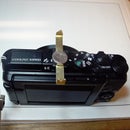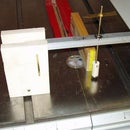Introduction: Find Exact Center and Drill Concentric Holes in Metal Rods
Finding and marking the exact center of a small metal rod or dowel is more difficult than finding the center of a larger circle. I recently wanted to mark the center of a 1" long x 3/8" diameter brass rod, then drill a 1/8" concentric hole the entire length. Yes, just a brass rod with a hole down the center. A professional machinist with a metal working lathe might have no problem with this, but for the average garage shop guy (me) it was no easy task. I learned a few tricks and made a jig that made the job easier and the results better.
With apologies to my friends in metric countries (everybody except U.S.), my example is in Imperial units. Everything applies to S.I. components and drill bits.
Step 1: Find the Center of the Rod - Method # 1
Method # 1 (not necessarily the best).
The classic method of finding the center of a round object is to use a center finder head attached to a standard metal rule, such as used in a combination square. You hold the round item in the V-notch and scribe a fine line. That line is a diameter of the circle. Rotate the piece, and scribe another line. Where the two lines intersect is the center. Easy and accurate for large circles (say over 1" diameter), not so easy for a 3/8" rod. Forget about using a pencil; use a sharp knife point, like an Exacto knife. Even with a sharp knife, the line can be a bit off center.
Step 2: Find the Center of the Rod - Method # 2
Method #2
Use a Forstner or brad point drill bit the same size as the rod. The point at the center will be reliably dead center. Place the rod and drill bit on a hard flat surface, and with the point of the bit scribe a couple of lines on the rod end. Where the lines intersect will be the center.
Step 3: Find the Center of the Rod - Method # 3
Method #3.
Insert the rod into the chuck of a power drill. Generally the chuck will accept up to 1/2" diameter. A drill chuck should center the rod exactly, but run the drill slowly to confirm there is no wobble or runout. Now you will need to hold the drill firmly; you may need a helper, or clamp the drill down somehow.With a hard tip scribe or punch, move the point slowly toward center of the rod. As you approach center, the tip will tend to go around in smaller and smaller circles. At dead center, if you press the tip to the rotating rod, it will not move at all. So, you found the center without marking any lines - and now you can mark the center point by pressing the tip into the rod or tapping the scribe with a mallet.
Step 4: Center Punch a Dimple
Marking the exact center with a center punch can be tricky; I have to use a magnifying lens to get the punch at the intersecting lines. That is the beauty of Method #3; you get at least a small punch mark when you locate the center. I bought a fancy (and expensive) optical center punch from Lee Valley tools, shown in the photo. With this you can locate the intersection of center lines with the optical cross hairs, then insert the steel punch to mark center.
You need a center punched dimple to drill into any metal object.
Step 5: Make the Jig
This jig will make it possible to drill your concentric hole straight down the axis of the rod.
Start with a block of softwood scrap, like the piece of 2x4 in the photo, clamped to the table of a drill press. Then drill a hole of the same diameter as the rod through the wood block; 3/8" diameter in this example. Remove the drill bit and insert the rod into the hole you just drilled. It should be a snug fit. It is best to not remove the block; leaving it securely clamped will assure that everything remains aligned.
Step 6: Drill the Concentric Hole

Participated in the
Epilog Challenge V













